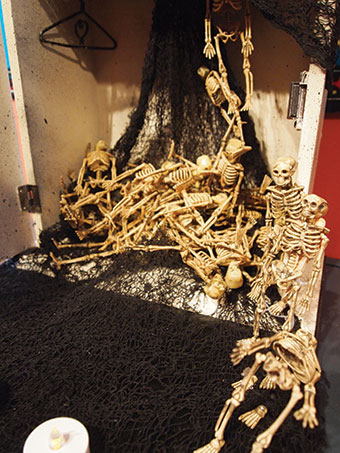Next story: An Exhibit on Disabled Veterans at People Inc.'s Museum of disAbility
Dia de los Muertos Altars Exhibit at El Museo
by Jack Foran



Altars of the Dead
Local physician and artist Milton M. Weiser’s recasting of 16th-century German master Matthias Grünewald’s multi-panel Isenheim Altarpiece as a Holocaust commemorative work is the centerpiece of the Dia de los Muertos altars exhibit at El Museo Francisco Oller y Diego Rivera.
It is an enormously affecting work. The Grünewald model features what is probably the most excruciatingly poignant depiction of Christ’s crucifixion in Western art history. Weiser’s version replaces Christ and surrounding saints with historical victims of the Holocaust and associated Nazi atrocities. Weiser’s crucifixion figure is one Dr. Janusz Korczak. Christ’s crucifixion is theologically interpreted as self-sacrifice. Accompanying explanatory material describes how Dr. Janusz refused to abandon orphans under his care.
Lateral figures to the Grünewald crucifixion scene are St. Sebastian, pierced by arrows, and St. Anthony, patron saint of the monastery hospital in Alsace-Lorraine for which the work was produced. St. Sebastian is replaced by Masha Bruskina, described as a heroine of the resistance, depicted in the death throes of her execution by hanging. She was accused of providing food to Russian Army prisoners of war. Replacing St. Anthony is Volodia Scherbatsevich, described as a hero of the resistance and Masha’s companion, who was hanged with her. A remarkable accompanying photo shows Masha, suspended, dead or dying, as a Nazi officer adjusts a noose around the neck of Volodia.
A key figure in the Grünewald crucifixion scene is Mary Magdalene at the foot of the cross in a pose of utter distress, utter anguish, at the vision of Christ crucified. She is replaced in the Weiser work by the figure of a young woman who is also shown in a photo in a pose (in both the photo and the painting) astonishingly similar to the Mary Magdalene pose in the Grünewald scene. Explanatory material says that the young woman in the photo was assaulted during an anti-Semitic pogrom, and it seems clear from the photo that it was sexual assault. Her pose and look is one of incomprehension of the inhumanity of what has just happened to her.
There is also a peaceable kingdom or paradisal scene in the Weiser work, featuring the principal figures in the previous scenes—Dr. Janusz, Masha, etc.—and a number of children of Warsaw. Another panel raises and rejects the proposition of “Hass immer Hass,” hatred begets hatred, forever.
The various panels of the Weiser work are medium-sized photos (that look like paintings) of the much larger actual paintings on wood.
There are about 20 altars in the Dia de los Muertos exhibit, commemorating a wide range of different types of personal or perhaps larger societal losses.
An altar by Bryan Ball commemorates poet Edgar Allen Poe and the mysterious tradition (mysteriously discontinued this year, perhaps indicating the passing of the author of the practice) of a bottle of spirituous liquor turning up on his grave in Baltimore each year on his birthday. The altar is constructed of boards that could be floorboards, a small section of which is missing, exposing the hollow area below, containing a plastic replica (so not actually beating in this case) of a human heart. The altar is strewn with black feathers, and presents hand-written portions of some of Poe’s poems and stories, and a bottle of what looks like an excellent cognac and two small apéritif glasses. So the tradition carries on. Transported from Baltimore to Buffalo.
An altar by Spanish language students from North Tonawanda Middle School features copious mandalas and replica skulls, and one by Carol Coventry commemorates the life and recent death of a beloved pet kitten called Mr. Lucky, incorporating some of his worldly treasures, including several toy mice. Mr. Lucky was orange-golden with a white star on his forehead.
An altar by Ari Moore, called Mother Tree, commemorates a cohort of drag queens and female impersonators who have now passed.
A commemorative altar of unclear precise reference, called simply In Memoriam, is by the artist team of Tim and Phoebe Raymond.
And one by artist d. katz, featuring numerous sculptural skulls and bones, is on an Aztec idea about what happens to children when they die. According to an Aztec story, they become butterflies.
The Dia de los Muertos altars exhibit continues through November 25.
blog comments powered by Disqus|
Issue Navigation> Issue Index > v10n45 (Week of Thursday, November 10) > Art Scene > Dia de los Muertos Altars Exhibit at El Museo This Week's Issue • Artvoice Daily • Artvoice TV • Events Calendar • Classifieds |









 Current Issue
Current Issue